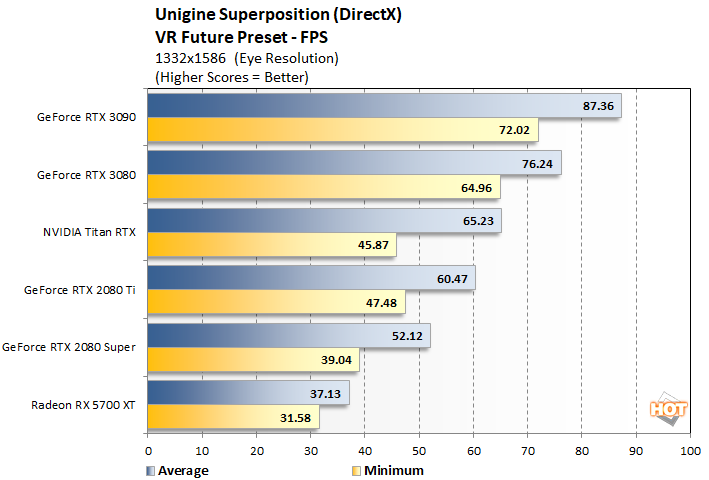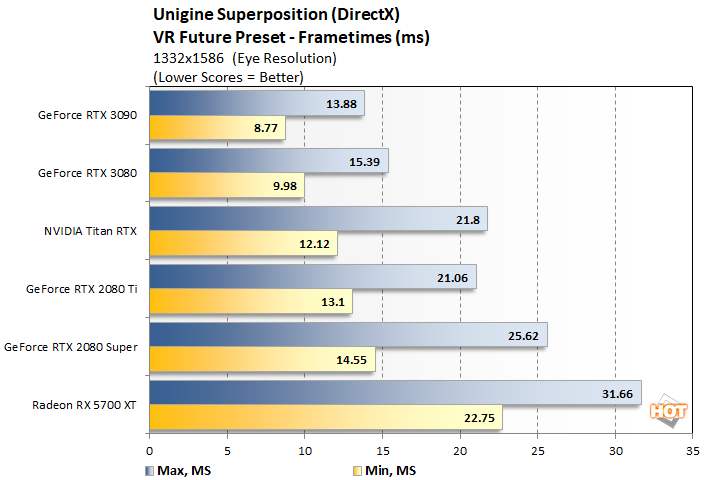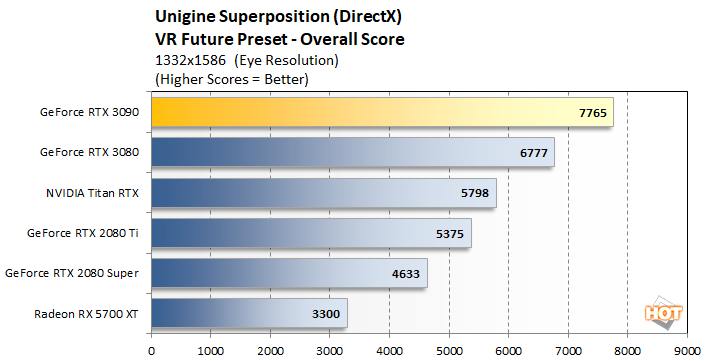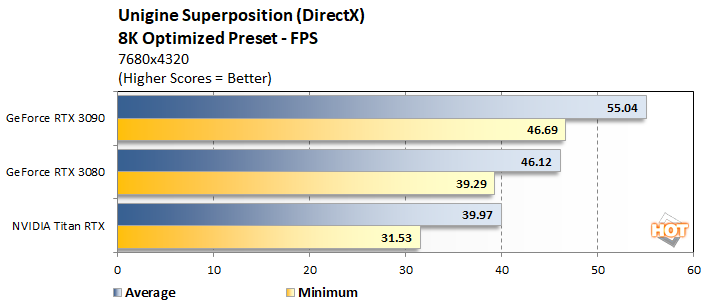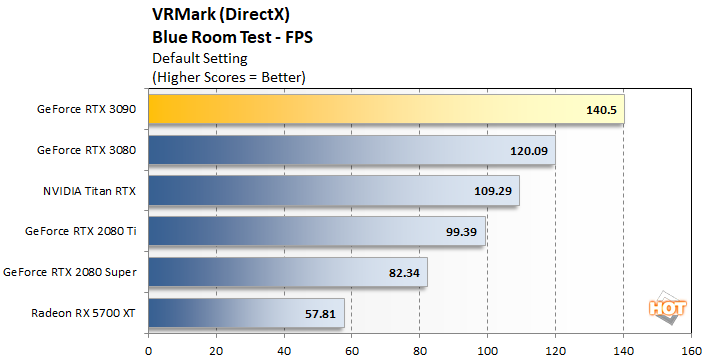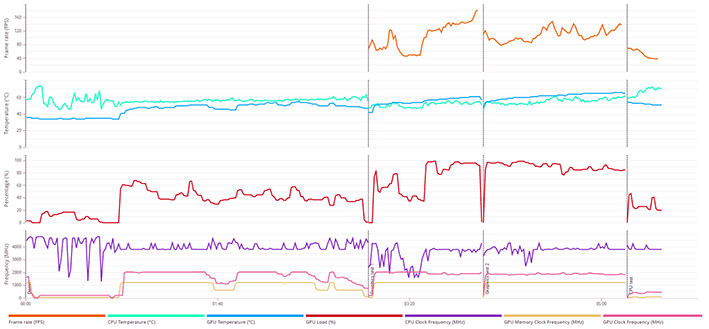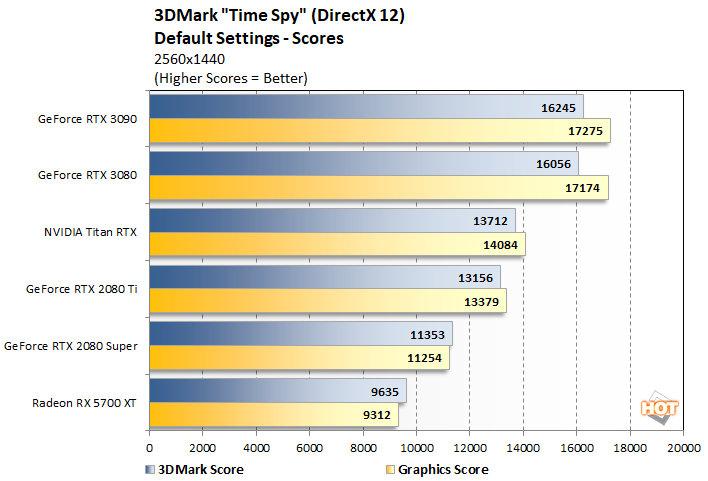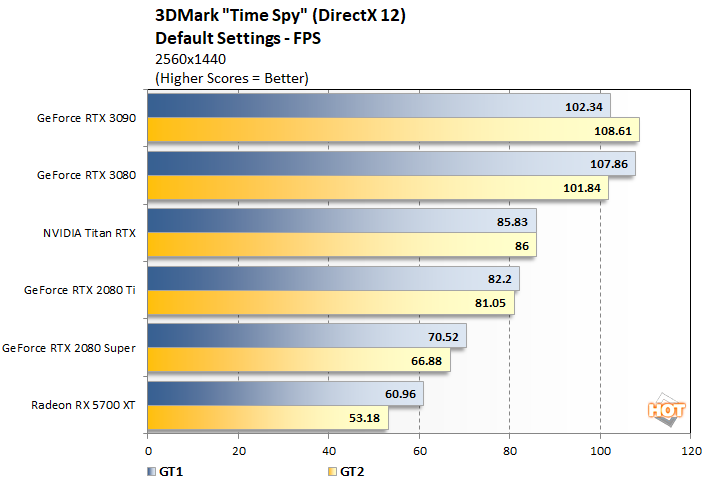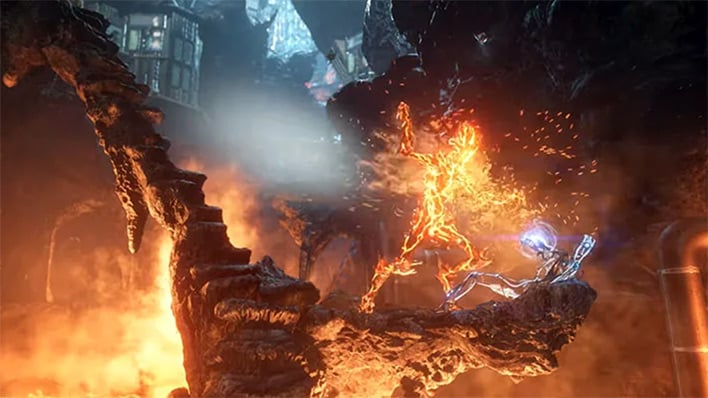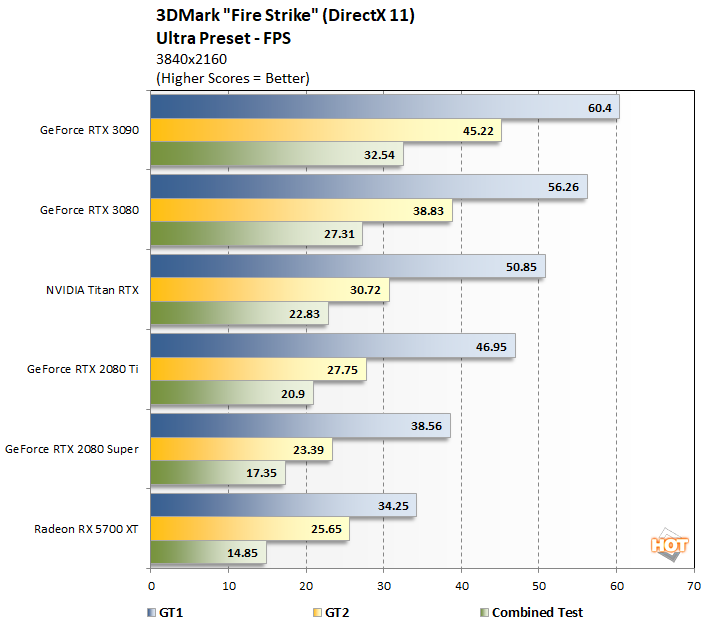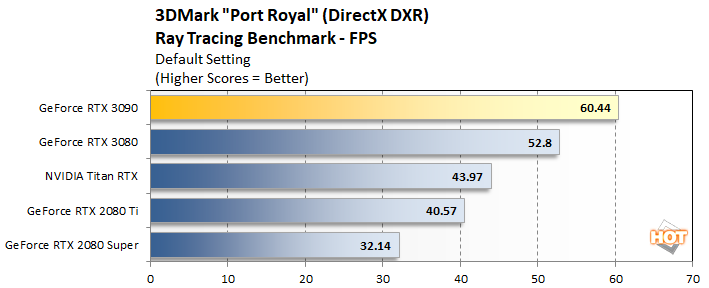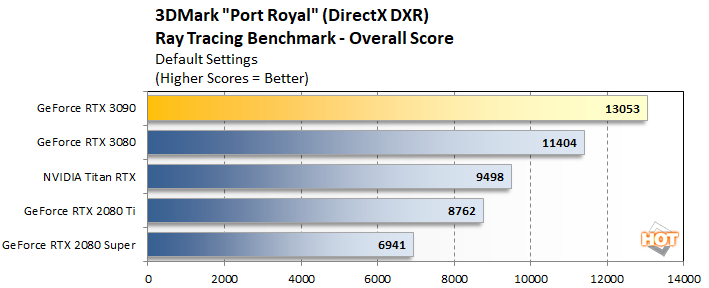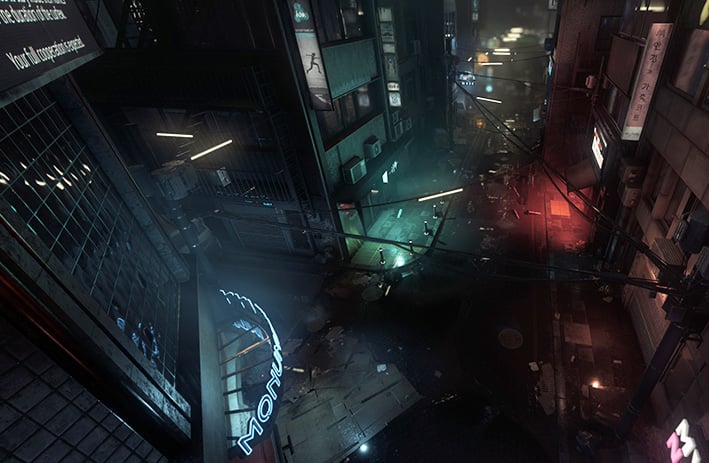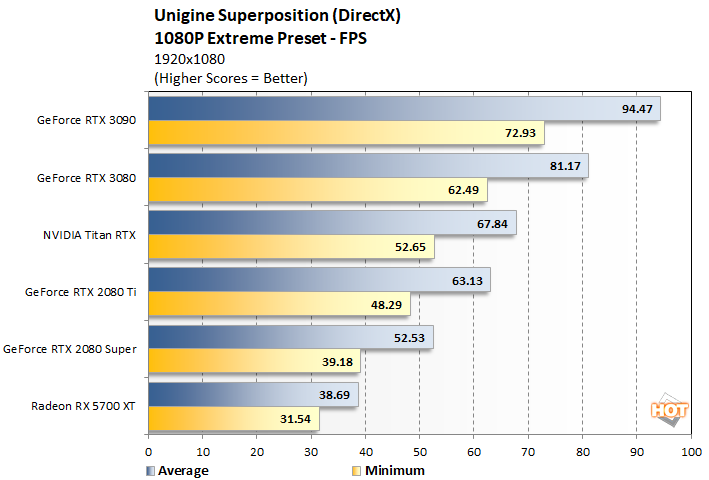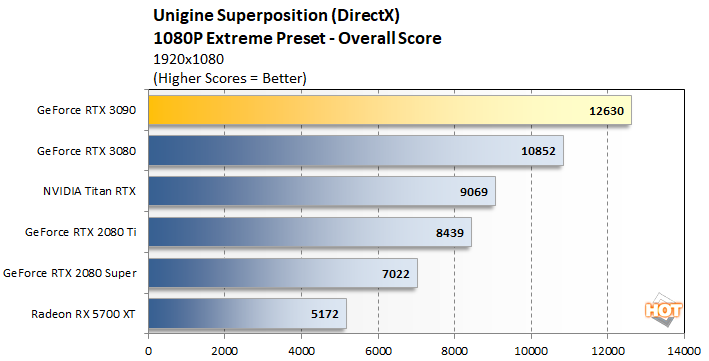Superposition is a relatively new benchmark from Unigine, powered by the UNIGINE 2 Engine. It offers an array of benchmark modes, targeting gaming workloads as well as VR, with both DirectX and OpenGL code paths.
|

|
| Unigine Superposition |
| Pseudo-DirectX / OpenGL Gaming |
|
Unigine Superposition uses the developer’s unique SSRTGI (Screen-Space Ray-Traced Global Illumination) dynamic lighting technology, along with high quality textures and models, to produce some stunning visuals. We ran Superposition in three modes using the DirectX code path – 1080p Extreme,
VR Future, and 8K Optimized -- to compare the performance of all of the graphics cards featured here.

Unigine Superposition


Unigine Superposition's 1080P Extreme test has the GeForce RTX 3090 outgunning the RTX 3080 by a little over 16% and the Titan RTX by nearly 40%.
The overall performance trend remains the same with Superposition's
VR Future test, but the deltas separating the cards shrink somewhat. Here, the GeForce RTX 3090 is only about 14.5% faster than the RTX 3080. It is still much faster than the Titan RTX, or anything else below it for that matter.
If we crank things up to 8K resolution (at least virtually -- the benchmark uses resolution scaling to evaluate 8K in lieu of an actually monitor capable of displaying the resolution), the GeForce RTX 3090's leads over the RTX 3080 and Titan RTX jump back up to over 19% and 37%, respectively.
 |
| UL VRMark |
|
Testing Rift And Vive Readiness |
|
UL's VRMark is designed to test a PC’s readiness for the
HTC Vive and
Oculus Rift virtual reality headsets. The benchmark does not, however, require that one of the headsets is attached to the PC to run and it uses an in-house graphics engine and content to ensure comparable results between different platforms. We ran the "Blue Room" VRMark test at defaults settings here, which is currently the most taxing test offered by the tool.
 UL VRMark
UL VRMark

GeForce RTX 3090 VRMark Details


We saw more of the same with VRMark's "Blue Room" test, where the GeForce RTX 3090 outpaced the 3080 by 17% and the Titan RTX by nearly 29%.
 |
| UL 3DMark Time Spy |
|
Direct X 12 Performance |
|
3DMark Time Spy is a synthetic DirectX benchmark test from Futuremark. It features a DirectX 12 engine built from the ground up to support bleeding-edge features like asynchronous compute, explicit multi-adapter, and multithreading. Time Spy is designed to test the
DirectX 12 performance of the latest graphics cards using a variety of techniques and varied visual sequences. This benchmark was developed with input from AMD, Intel, Microsoft, NVIDIA, and the other members of the Futuremark Benchmark Development Program, to showcase the performance and visual potential of graphics cards and other system resources driven by close-to-the-metal, low-overhead APIs.

GeForce RTX 3090 Time Spy Details


In the default
DX12-based 3DMark Time Spy benchmark, the GeForce RTX 3080 and RTX 3090 are effectively CPU bound, with only 1.1% separating the two cards. The Titan RTX, however, falls victim to the GeForce RTX 3090 by about 18.5%.
|

|
| UL 3DMark Fire Strike |
| Synthetic DirectX Gaming |
|
3DMark Fire Strike has multiple benchmark modes: Normal mode runs at 1920x1080, Extreme mode targets 2560x1440, and Ultra mode runs at a 4K resolution. GPU target frame buffer utilization for normal mode is 1GB and the benchmark uses tessellation, ambient occlusion, volume illumination, and a medium-quality depth of field filter. The more taxing Extreme mode targets 1.5GB of frame buffer memory and increases detail levels across the board. Ultra mode is explicitly designed for CrossFire / SLI systems and cranks up the quality even further. GT 1 focuses on geometry and illumination, with over 100 shadow casting spot lights, 140 non-shadow casting point lights, and 3.9 million vertices calculated for tessellation per frame. GT2 emphasizes particles and
GPU simulations.

3DMark Fire Strike

GeForce RTX 3090 Fire Strike Ultra Details


Our results in the DX11-based Fire Strike benchmark have the GeForce RTX 3090 finishing in the overall lead yet again, with scores 13% and 34% better than the GeForce RTX 3080 and Titan RTX, respectively, and nearly double the Radeon RX 5700 XT.
 |
| UL 3DMark Port Royal |
| DXR Ray Tracing Benchmark |
|
Port Royal was released around the same time Turing hit the market, as an update to UL’s popular 3DMark suite. It is designed to test real-time ray tracing performance of graphics cards that support Microsoft DirectX
Ray Tracing, or DXR. Although
DXR is technically compatible with all DX12-class GPUs, the graphics card must have drivers that enable DXR, and NVIDIA is the only company to have done so at this point, hence the lack of Radeons in the chart. Hopefully, that changes soon when RDNA2-based Radeons are announced late next month.
 3DMark Port Royal
3DMark Port Royal

GeForce RTX 3090 Port Royal Details
By this point, we must be sounding like a broken record, but the numbers are what they are. With 3DMark's Port Royal ray tracing test, we see the GeForce RTX 3090 finishing in the lead yet again, out in front of the GeForce RTX 3080 by roughly 14.4%.
 |
|
Crytek Neon Noir |
|
API Agnostic Ray Tracing Test |
|
Crytek’s Neon Noir demo was created with an advanced version of CRYENGINE’s Total Illumination technology, which will be used in the
upcoming Crysis Remastered to enhance the game’s visuals. Neon Noir was developed on a customized version of CRYENGINE 5.5., and is both API and hardware agnostic. It enables ray tracing to run on virtually any modern GPU, however, future integration of the technology will be optimized for the latest GPUs and APIs like Vulkan and DX12.

Chalk up another clear victory for the GeForce RTX 3090. Here, NVIDIA's latest wunderkind leads the pack by 16.6% (GeForce RTX 3080) to 192% (AMD Radeon RX 5700 XT).
